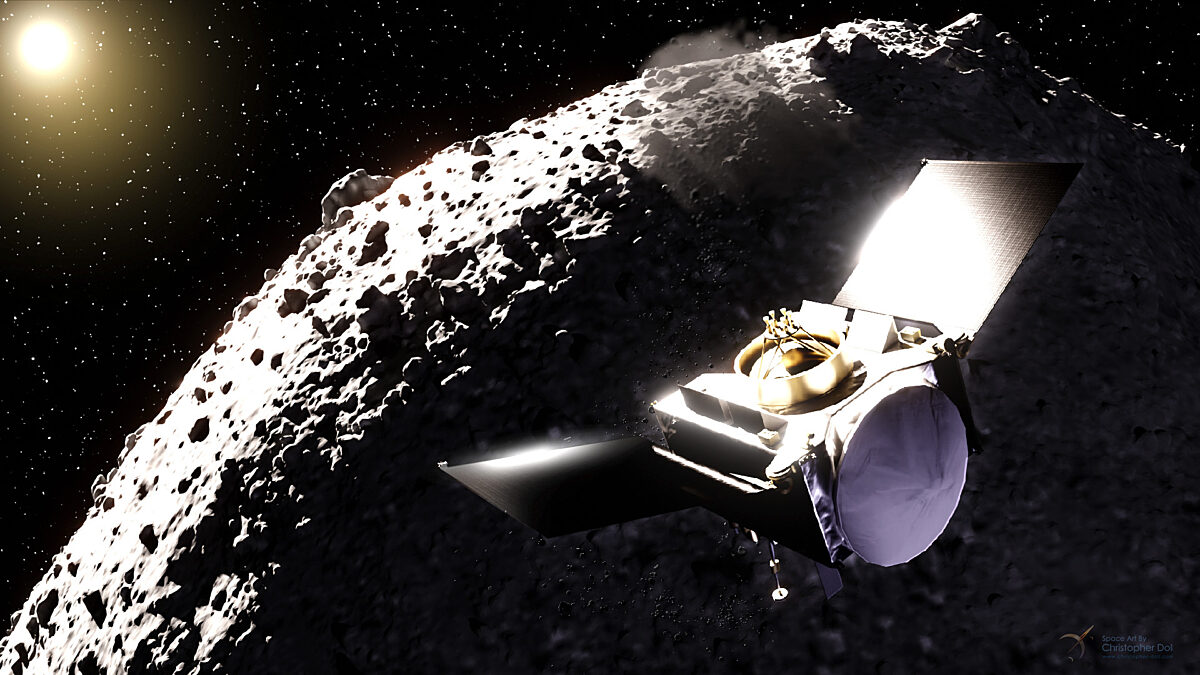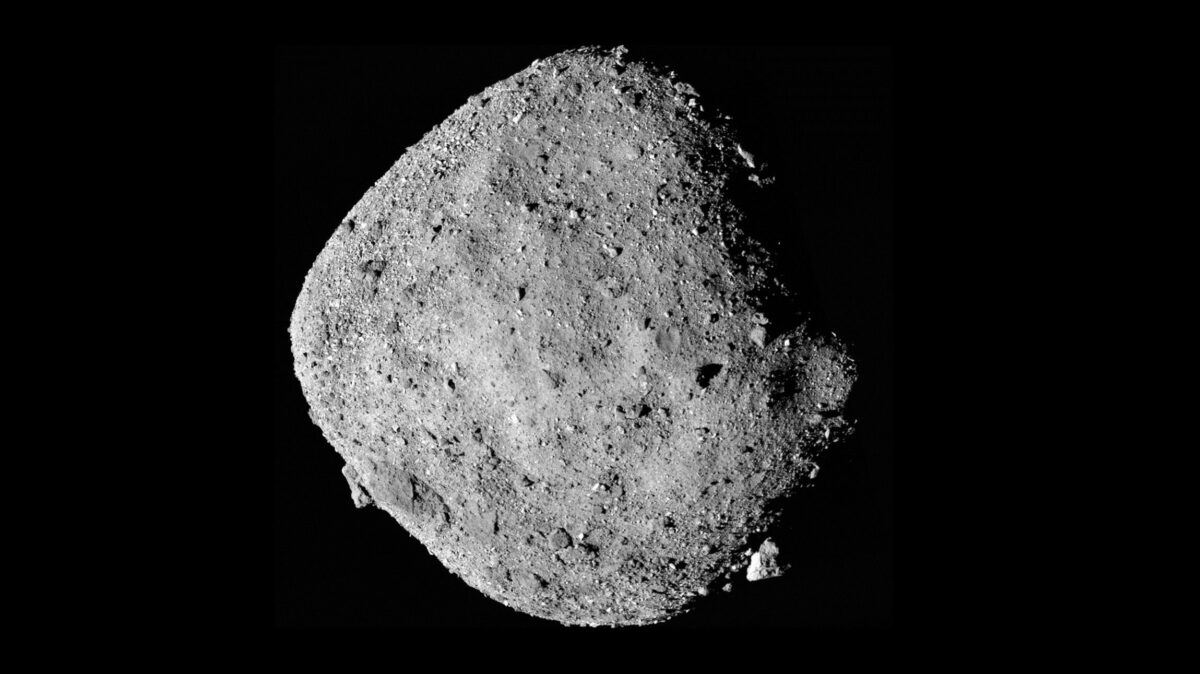OSIRIS-APEX, NASA's asteroid Apophis chaser
Highlights
- OSIRIS-APEX will catch up to the asteroid Apophis after the space rock barely avoids hitting Earth in 2029.
- By visiting Apophis, OSIRIS-APEX will help us learn about the Solar System's past and how to prevent future impacts.
- Apophis would cause massive destruction if it collided with Earth, but astronomers are confident that the asteroid will not hit us for the foreseeable future.
What is OSIRIS-APEX?
OSIRIS-APEX is a mission to shadow Apophis, a giant asteroid, just after the rock barely avoids hitting Earth. If successful, OSIRIS-APEX will take modern humanity’s closest call with a major asteroid and turn it into an opportunity: a chance to better understand asteroids, learn more about how the Solar System formed, and help prevent future impacts.
On April 13, 2029, the asteroid Apophis — which is about as tall as the Empire State Building and three times as wide and long — will pass closer to Earth than the orbits of some satellites. If the asteroid hit Earth, the energy of the collision would be roughly equivalent to 1,000 of the most powerful nuclear bombs in the United States’ arsenal.
But Apophis won’t hit Earth. Instead, OSIRIS-APEX will watch from a distance as the asteroid flies by, then catch up to study it in more detail. The spacecraft will map Apophis, track its trajectory, and eventually fire thrusters to stir up its surface.
If this sounds familiar, that’s because OSIRIS-APEX is an extension of NASA's OSIRIS-REx mission to study the asteroid Bennu and collect rocks from its surface. After the probe successfully sent samples back to Earth in 2023, it still had fuel left — so the mission charted a course for Apophis and was reborn under a new name.

Why is NASA sending a spacecraft to Apophis?
The Apophis close approach is a rare event. It offers clues about the Solar System’s past and a lesson in how to save humanity from future impacts.
As the leftover building blocks of the Solar System, asteroids are a window into how the planets — including Earth — formed and evolved. But most are too small and far away to be studied in detail from the ground. By sending a probe, NASA will be able to map Apophis down to millimeter scales and more precisely measure its chemical makeup.
At the same time, asteroids are a major threat to life on Earth. The information that OSIRIS-APEX gathers will help scientists understand the forces that shape asteroid orbits, improving our ability to predict which might hit us in the future — and maybe, one day, even redirect one on a collision course with Earth.
The 2029 near-miss provides an especially unique opportunity. An encounter this close with an asteroid as big as Apophis is estimated to happen only once every 7,500 years. Thanks to OSIRIS-APEX, humanity will have an unparalleled view.
What if Apophis hit Earth?
It would be the biggest explosion in recorded history. That record is currently held by a Soviet nuclear weapons test of about 50 megatons, powerful enough to wipe an entire metropolitan area off the map. Apophis would impact Earth with an energy around 20 times greater.
An Apophis impact on land would warp and collapse most steel-framed buildings within 15 kilometers (roughly 9.3 miles), a region about the size of New York City. It would destroy other ordinary buildings within a 40-kilometer (roughly 25-mile) radius, an area as big as Delaware. And if Apophis landed in the middle of Puerto Rico, it would flatten almost every tree on the island (a radius of 50 kilometers, or roughly 31 miles).
If Apophis fell into the ocean, it would carve out a crater about 7 kilometers (about 4.3 miles) wide before the seawater rushed back in. Any coastlines nearby would be at major risk for tsunamis. In one simulation, an Apophis splashdown off the coast of Portugal caused a 4-meter-high wave that hit almost a quarter of the country’s population.

How close will Apophis come to Earth?
It will be a very close pass. Apophis will come within about 32,000 kilometers (20,000 miles) of Earth — less than one-tenth the distance to the Moon. The asteroid will fly below the altitude of some satellites, but should arrive on a trajectory that makes any collision highly unlikely.
How do we know that Apophis won’t hit us?
Astronomers have taken thousands of observations over nearly 20 years to build an extremely precise model of Apophis’ orbit. They can predict where Apophis will be during the 2029 flyby up to a factor of just a few kilometers. Though there was a time when the chances of Apophis hitting Earth were as high as 1 in 37, that was when scientists had fewer, less precise measurements to work with. Now there is no chance of impact in 2029, and astronomers have all but eliminated the possibility of a collision over the next hundred years.
What will OSIRIS-APEX do?
When Apophis flies by Earth in April 2029, OSIRIS-APEX will be following close behind. The spacecraft will pass just an hour after the asteroid, performing a gravity assist to catch up to it a little over a week later.
After gradually maneuvering closer, OSIRIS-APEX will begin mapping the asteroid and measuring its shape, mass, and chemical composition. These data will allow the mission team to select a site for the STIR (Spacecraft Thruster Investigation of Regolith) maneuver, when the probe will fire its thrusters at Apophis to throw off some the outermost surface and reveal what is underneath.
Next, OSIRIS-APEX will begin a 1.5-year campaign to monitor the orbit of Apophis from up close. It will be particularly focused on measuring how thermal radiation from Apophis affects its trajectory. This phenomenon, called the Yarkovsky effect, remains a major obstacle to predicting which asteroids might impact Earth.

What will NASA do with OSIRIS-APEX when its mission is over?
The OSIRIS-APEX mission should still have plenty of fuel left after finishing its science operations. Since it will have completed all of its goals and more by then, the mission team is considering a “high-risk, high-payoff” finale that would defy the typical measures taken to protect a multi-million-dollar spacecraft.
One idea would be to try reextending the sample collection arm — which is not guaranteed to still work after its operation on Bennu — and then use it to tap Apophis and shake the surface. OSIRIS-APEX could then fire a canister of nitrogen gas (also no longer guaranteed to work) to stir things up even more. If the spacecraft is still functional after all that, it would back away to witness the aftermath.
Or OSIRIS-APEX could land on Apophis. There, it would act as a radio beacon that would allow astronomers to keep measuring the asteroid’s orbit until it ran out of power.
Could OSIRIS-APEX accidentally push Apophis toward Earth?
No. Under the current mission plans, the biggest nudge that OSIRIS-APEX will give Apophis would have to be 10,000 times stronger to even affect estimates of the asteroid’s trajectory.
What’s the difference between OSIRIS-APEX and OSIRIS-REx?
It’s the same spacecraft on a different mission. After visiting the asteroid Bennu and sending its Sample Return Capsule back to Earth, the OSIRIS-REx spacecraft had enough fuel left over to travel to Apophis. So, NASA extended the mission under a different name. The agency kept the OSIRIS part, which stands for Origins, Spectral Interpretation, Resource Identification, and Security, but replaced Regolith Explorer (REx), with APophis EXplorer (APEX). The role of principal investigator shifted from Dante Lauretta to Dani DellaGiustina, both at the University of Arizona, while the sample analysis team split off to study the rocks OSIRIS-REx dropped to Earth. Otherwise, the scientists working on the two projects are similar. NASA’s Goddard Space Flight Center continues to manage the mission.
How to see Apophis
At its closest approach on April 13, 2029, Apophis will be visible to the naked eye from Europe, Africa, and parts of Asia. The asteroid will be about three times dimmer than Polaris. That will make it visible from darker sites without any special equipment and from slightly brighter areas with binoculars. Though it won’t be extremely bright, Apophis will be recognizable from its motion: it will shift about a Moon’s width in the sky every minute or so.
How has The Planetary Society been involved?
The Planetary Society has a long history of rallying scientists, politicians, and the public around Apophis and its importance to planetary defense. Every year, our leaders join an international coalition coordinating preparations for the 2029 flyby. We have helped asteroid scientists communicate their work to others and have advocated for a mission to Apophis in the Planetary Science Decadal Survey. In 2007, we hosted a competition to design a probe that would shadow Apophis and determine whether it would impact Earth. Six years later, we helped a nine-year-old boy name the asteroid that OSIRIS-REx visited before it became OSIRIS-APEX, organizing a contest in partnership with the University of Arizona and the Lincoln Near Earth Asteroid Research survey at the Massachusetts Institute of Technology. Lastly, thanks to a collaboration between NASA, the University of Arizona, and The Planetary Society, the names of over 442,000 people are flying with OSIRIS-APEX (on a microchip) as it pursues its historic mission.


 Explore Worlds
Explore Worlds Find Life
Find Life Defend Earth
Defend Earth

